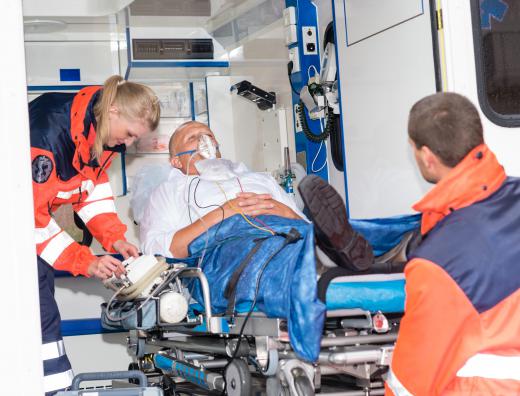What Is Suspended Animation?
Suspended animation is a state induced by several means were a living body's processes are slowed down to the extent that the body is neither alive nor dead. To all appearances, the body appears dead because life functions like heartbeat and breathing are virtually undetectable except by medical devices. It was originally a concept that only existed in science fiction, but there are many research efforts dedicated to making it a reality. Researchers believe that the process, when perfected, will give medical staff more time to treat critical wounds and save lives that would be lost otherwise.
In suspended animation, the body is artificially put into a state that is at the edge of death. Experiments on animals are being conducted in a few research labs, and they all employ different methodologies. One approach attempts to inject a cold fluid into the body to induce a severe state of hypothermia. When the body's temperature lowers beyond a certain point, all metabolic processes also slow down. This saves the body from dying of a critical injury.

Cooling the body and flushing the veins with an organ-preservation liquid induces a state of suspended animation. Pigs were used as test subjects, and injuries were inflicted on their bodies after 60 percent of their blood was removed. The pigs entered states of suspended animation, and surgeons used the time to repair the otherwise fatal injuries. When their body temperatures were bought to normal levels, the pigs survived the procedures without any cognitive damage.
The body is cooled to reduce its demand for oxygen. When a body suffers trauma, its demand for oxygen is quite high, but the supply is low due to blood loss. As a result, the body suffers brain damage first, followed by death in a very short time. By slowing down the metabolic activity, the body's oxygen needs decrease, giving more time for medical personnel to attend to the damage.
Another research effort induces suspended animation by poisoning the body with a toxic gas like hydrogen sulfide. The idea here is to keep the body alive in an oxygen-deprived environment by reducing its oxygen demands. When exposed to high concentrations of gas that are slightly below toxic levels, the body enters a state of suspended animation. This approach is inspired by the way animals hibernate, in which an organism's biological activities shut down when the amount of oxygen in the air reaches a critical level.
If the body is given a hit of the toxic gas for a specified length of time, it depresses metabolic functions and brings down oxygen needs. Respiration drops, and the body requires fewer breaths and very little oxygen. It becomes possible to stay in a state between life and death by providing an atmosphere containing very little quantities of oxygen. The body is revived by bringing the oxygen levels back to normal.
Surgeons, trauma care specialists, and ambulance personnel believe that this procedure will allow better survival rates — once the body is shut down, the the surgeons will have around one to one and a half hours to operate and repair damage. Seen as a last resort to save people with otherwise fatal injuries, this procedure could give accident, heart attack, and stroke victims the critical minutes they need to reach a hospital before irreversible bodily damage is done. Once perfected, the process will also allow long-term space travel.
AS FEATURED ON:
AS FEATURED ON:











Discussion Comments
@KoiwiGal - People misuse every kind of technology already, I don't think suspended animation would be any different. And it would be such an enormous boon to medical science I do hope they develop a safe and sustainable method of performing it soon.
@pleonasm - I have read a short story where cryogenics like this was used as a form of population control, so that half of the population of a city would be asleep at any one time leaving the rest of them to enjoy more space. But I feel like this would really encourage a kind of voyeur sensibility and that's something we have enough of already. You can't really participate in the world if you are going to skip the boring bits. That's one of the reasons they always make rumors about rich and powerful people being put into suspended animation rather than simply dying, because in the public imagination, someone who survives for generations is a person apart.
I've always wondered whether this technique will be used for more than just space voyages when it's perfected. I know the classic trope is for people to use it in order to survive until their illness can be cured, but I think it would be very tempting to use as a means of time-travel, even if it was only into the future.
If you were willing to do this, you'd be able to see a huge swathe of human history and how humanity develops, as well as being able to capitalize on advancements in technology. And I know that people will say that you'd have to leave your loved ones behind, but in theory they could just come along with you in the same freezer.
Post your comments